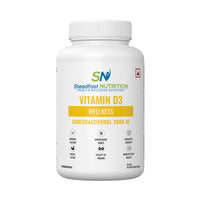Hypervitaminosis refers to the presence of an excess amount of vitamins in the body.
Vitamins are broadly classified into two categories - Water-soluble and Fat-soluble vitamins. As the name says, water-soluble vitamins like vitamin B-complex and C require water as a medium for absorption in the body. Due to this, if they are present in excess, our body eliminates them through sweat and urine.
Fat-soluble vitamins require fat for their absorption and don’t get excreted out of the body via urine. Instead, they accumulate in our body leading to toxicity or hypervitaminosis.
Therefore, hypervitaminosis indicates toxicity which occurs due to excess accumulation of vitamins.
In this article, we will specifically look at the symptoms of toxicity of fat-soluble vitamins - A, D, E and K.
HYPERVITAMINOSIS A
It refers to an excess of vitamin A in the body. Vitamin A is very important to keep our vision health strong. In addition, it is a powerful antioxidant that keeps our brain, heart, brain and skin healthy. Vitamin A toxicity might occur due to overuse of supplements. The toxicity may be acute or chronic. Acute toxicity might cause bone pain, poor vision and skin health. But if it becomes chronic then may damage our liver, kidney, bones and brain.
Some of the symptoms of vitamin A toxicity are irritability, nausea, vomiting, abdominal cramps, blurred vision, loss of appetite, cracked, itchy, dry skin, hair fall, poor immune health, mouth ulcers, swelling and pain in bones.
Therefore, it is important to maintain healthy levels of vitamin A in the body through consuming vitamin-rich foods in the diet like yellow and orange coloured fruits and vegetables, dark green leafy vegetables, egg yolk, cheese, milk and organ meat like liver.
HYPERVITAMINOSIS D
Vitamin D is another critical nutrient required to maintain a healthy bone density, strong renal immunity, cardiovascular and brain health. It is involved in multiple biochemical processes taking place in the body. Vitamin D assists in the absorption of calcium and phosphorus in the body which is needed to keep our bones and teeth strong. Lack of vitamin D is associated with an increased risk of infections and illnesses.
Vitamin D toxicity can not occur through diet. It is mostly seen among people consuming large doses of vitamin D supplements for a prolonged duration. Vitamin D toxicity occurs when blood levels reach more than 150 ng/ml.
Elevated levels of vitamin D in the body increases the levels of calcium as well. It can lead to nausea, vomiting, constipation, abdominal discomfort and loss of appetite. High vitamin D levels increase calcium but decrease vitamin K2 levels in the body which is involved in bone metabolism. This can lead to the weakening of bones, excess leaching of bone calcium in the blood making our bones porous, soft and prone to osteoporosis. Since kidneys play a very important role in vitamin D metabolism, hence high vitamin D levels may cause renal failure as well.
Therefore, vitamin d capsule should be carefully consumed with regular monitoring.
HYPERVITAMINOSIS E
Vitamin E is known for its powerful antioxidant role in the body. It is needed to reduce the risk of many cancers, brain disorders, heart diseases, keep blood vessels and skin healthy.
Vitamin E is abundantly found in nuts, olive oil, olives, seeds, seed oils, mango, spinach and broccoli. Vitamin E is also popularly used by people to keep their skin healthy, reduce the signs of ageing, wrinkles, strengthen their hair and boost immunity.
But overuse of supplements might lead to vitamin E toxicity. It can cause blood thinning and bleeding. Because it is involved in the blood clotting action of vitamin K, therefore high levels may augment the probability of heart diseases, excessive bleeding and haemorrhage.
HYPERVITAMINOSIS K
Vitamin K is essential for the blood clotting process in the body. It acts as a cofactor for many clotting factors and is needed for the synthesis of coagulation proteins. Our body contains vitamin K in two active forms - K1 or phylloquinone and K2 or menaquinone.
Hypervitaminosis of vitamin K might occur in the case of overuse of synthetic form of vitamin K as menadione. Some of the clinical manifestations of its toxicity are jaundice, elevated bilirubin levels and haemolytic anaemia.
To sum up, nutrients like vitamins and minerals are essentially required by us. They are good for the body only when consumed as per recommended allowance to maintain the levels. Excess of anything is harmful to our health which is applicable to fat-soluble vitamins as well. High levels of vitamin A, D, E and K lead to toxicity associated with their own set of health complications.
REFERENCES
• Olson JM, Ameer MA, Goyal A. Vitamin A Toxicity. [Updated 2021 Feb 11]. In: StatPearls [Internet]. Treasure Island (FL): StatPearls Publishing; 2021 Jan-. Available from: https://www.ncbi.nlm.nih.gov/
• Marcinowska-Suchowierska, E., Kupisz-Urbańska, M., Łukaszkiewicz, J., Płudowski, P., & Jones, G. (2018). Vitamin D Toxicity-A Clinical Perspective. Frontiers in endocrinology, 9, 550. https://doi.org/
• Imbrescia K, Moszczynski Z. Vitamin K. [Updated 2020 Jul 10]. In: StatPearls [Internet]. Treasure Island (FL): StatPearls Publishing; 2021 Jan-. Available from: https://www.ncbi.nlm.nih.gov/


